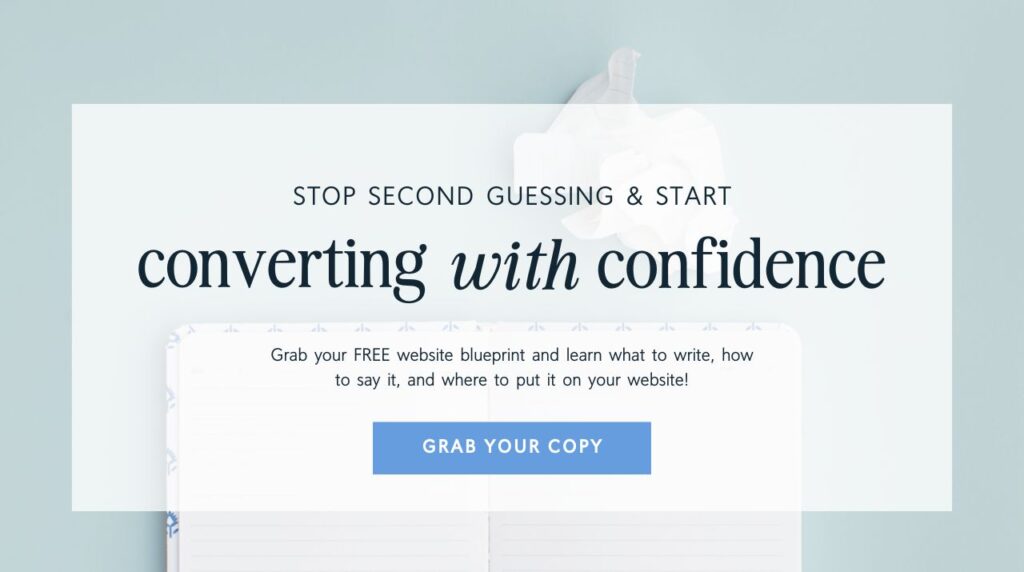If you started a private practice and are in the process of making your website (or maybe you already have one and you're looking to improve it), you might be wondering what exactly how to write a private practice website.
In my opinion, writing a website for a counseling-based private practice can be one of the most challenging parts of the project! As compassionate clinicians, we are trained to lead with our words, build rapport, and establish relationships. The thing is, we're usually trying to do that in conversation and not through website copy. There's an extra layer of frustration that comes in when you're someone who typically articulates really well, and can't seem to get your website just how you want it.
If that sounds like you, don't panic – we'll get through this together! Here are my best tips for how to write a private practice website.
How to Write A Private Practice Website: Best Tips from a Website Designer & Registered Dietitian

You might be wondering: Who's this girl to give me advice? Let me introduce myself – hi! I'm Amy, a dietitian (MS, RD, LD, CEDS to be specific) and website designer who's super into all the boring business stuff you're not, like what goes on your website, automations, and systems.
Even in my clinical jobs, I've found myself leaning toward the business and communications side of things through outreach, marketing, and leadership. Now, I make killer sites (usually for the dietitians I used to work with!) and have seen the good, bad, and ugly of the Internet. I'm here to share what I know, so you can err on the side of crushing it online.
1 | Aim for being informative without overdoing it
This is a common mistake I see made in a lot of websites, but the amount of copy you have can be pretty crucial in how accessible and appealing it is to someone reading it. If you have too little information (like sections missing, a short one-page site, etc) you run the risk of your potential clients feeling confused or indifferent to your practice and moving on to other options.
*Quick note: I think one-page sites are really wonderful if you’re just starting out or as a bridge while you’re extending your site! It’s just hard to fit in all the info you need + squeeze in enough SEO-focused copy on just one page. It’s also nice to be able to give clean, easy to share URLs when someone wants specific information (ex: yourwebsite.com/FAQ)
If you have too much copy, you run the risk of overwhelming potential clients, giving them too much information, being repetitive, and turning them off as well. A key thing to remember here is that website visitors don't read, they skim.
Here’s how to fix it:
- Limit your paragraphs to 4-5 sentences, maximum
- Use headers to highlight important information and increase your visitor’s ability to skim the page quickly for what they’re looking for
- Make a list of questions you typically get from clients during each stage of your onboarding process (learning about you, reaching out, discovery call, first session, etc). Ensure that your website clearly answers these questions. An FAQ section or page is great for this, but make sure the answers are also outlined in other places on the website!
2 | Anticipate your clients’ questions
If you've been practicing for long enough that you have your own company and you're starting a website, I'm going to assume that you've been in several interactions with clients and can probably anticipate some of their questions by now! I hinted at this in the last tip, but make sure your website is answering the questions your future clients WILL have, like:
- Where will we meet?
- How long are sessions?
- Do you take insurance?
- Do you have experience supporting people with…XYZ?
- What are your qualifications?
3 | Use your compassionate counseling skills
This is one of my favorite tips because it's so unique to people in the therapeutic space, and I think it's a really fun and creative way to view writing your website:
Think of your website as preparing your future clients for a therapeutic exposure.
Put yourself in the shoes of someone who maybe has never been in therapy before, or maybe has worked with a dietitian before but has never worked with you as their dietitian before. Couple that with the fact that reaching out for help is often a vulnerable and fragile stage of change, and you’ve got a lot of prime opportunities to establish trust in those first interactions – which often start on your website.
Here's how to do it:
- Explain what’s going to happen now. Talk clients through the process of beginning to work with you. Maybe you typically do a free discovery call to get to know each other before you book a session. Maybe you move people straight into an initial session from their inquiry. Maybe they actually need to get a referral from another provider and send it somewhere. Explain this path clearly.
- Explain what’s going to happen NEXT. On the confirmation page of your inquiry form, or in an automated email reply, let people know how long they can expect to wait before hearing from you, or what their next action item will be.
- Actually do what you said you’re going to do. This one seems obvious, BUT it’s a two-parter: you need to follow the process you lay out to prep clients, and you need to update the way you prep them as your processes change.
4 | Write About Yourself…Twice!
One of my favorite things to include when I write a private practice website for a dietitian, therapist, or other helping professional, is two bios. Typically, the page begins with a more casual bio written in the first person:
“Hi, I’m Hannah and I’m a registered dietitian who helps people rediscover the joy in eating.”
The goal of this bio is to humanize you and provide a little background information about you as both a provider and a person!
Your second bio is your “professional” bio – think: what would be read onstage about you if you accepted an award? If you were on a podcast? For a byline? This one is in the third person and more formal.
“Hannah Jones is a registered dietitian and Certified Eating Disorder Specialist (CEDS) providing clinical nutrition counseling in the field of eating disorders.”
The goal of this bio is to establish your credibility (and to save you time when you need to pull a professional bio for use – just send people to your About page!)
5 | Keep Your Site Updated
If you hire a new clinician, change your process, move offices, create a new offering, or literally anything else – one of your first moves should be reflecting that on the website. As a lead dietitian for a residential eating disorder treatment center, I frequently found myself in a unique position to help repair discontent that stemmed from our clients not seeing their assigned dietitians on the company website before admitting. In this day and age, we all expect websites to be well-maintained and it can make us nervous when websites say untrue things – however unintentional that is!
*Bonus: Google LOVES when websites are updated so it knows it's sending people to the most current information. Tweak often, even if it's small edits!
6 | Strike the Right Tone
When you're trying to write a private practice website, I recommend reaching for a tone that’s both accessible and informative. Believe me, I know you know a lot of modalities and acronyms and shorthand and that is AWESOME! You’re crushing the provider game and doing a great job. But when it comes to writing about this for clients, you want to aim for less technical jargon and more a more casual word choice.
Here’s how to do it:
- Write out acronyms | Example: cognitive behavioral therapy (CBT)
- Simplify your sentences | Example: “We use a clinically-supported individualized therapeutic approach to determine the most appropriate modalities and exposures to treat your presenting concerns” changes to “We take the time to get to know you, and use our therapeutic experience to help recommend the best paths to help you reach your goals.”
- Before you hit “publish,” pass your website off to some of your non-provider friends and ask them to describe what you do and how you do it. If they can't do that based on your website, time to edit!

share this post
« Search Engine Optimization Basics | SEO Terms You Need To Know
Making A Logo On Canva: The #1 Mistake You’re Making »